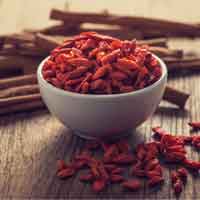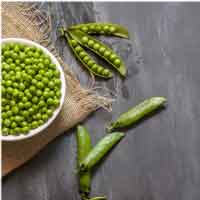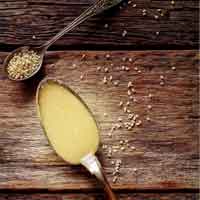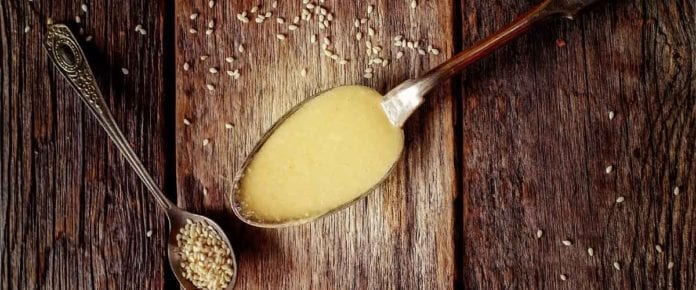 Goji Berries – Also called the wolfberry, this is the fruit of Lycium barbarum and is indigenous to Asia. The dried, red fruits are elongated and have been used in traditional Chinese medicine for centuries. Although said to be a natural remedy for everything from diabetes to malaria, these claims are still largely inconclusive. High in antioxidants and Vitamin C, they’re used as both a fruit and an herb. They’re slightly sweet and can be baked, cooked, steamed or processed in numerous ways. At Nota Bene, Lee says his cool-weather hit continues to be his take on an Asian Hot & Sour soup ($12). “We smoke the chickens and make a broth with them, which gives the soup a light, smoky, aromatic flavour. We add jalapeño peppers for spice and goji berries, which give it a medicinal, health aspect,” says Lee.
Goji Berries – Also called the wolfberry, this is the fruit of Lycium barbarum and is indigenous to Asia. The dried, red fruits are elongated and have been used in traditional Chinese medicine for centuries. Although said to be a natural remedy for everything from diabetes to malaria, these claims are still largely inconclusive. High in antioxidants and Vitamin C, they’re used as both a fruit and an herb. They’re slightly sweet and can be baked, cooked, steamed or processed in numerous ways. At Nota Bene, Lee says his cool-weather hit continues to be his take on an Asian Hot & Sour soup ($12). “We smoke the chickens and make a broth with them, which gives the soup a light, smoky, aromatic flavour. We add jalapeño peppers for spice and goji berries, which give it a medicinal, health aspect,” says Lee.
 Pisum Sativum, or English peas, typically herald the beginning of spring, their peak growing season that extends into early summer. The peas are a legume belonging to the Fabaceae family, which have large, bright green pods that grow on vines — encasing plump, round peas. They’re slightly crunchy with a sweet pea, vegetal flavour. If not eaten quickly, their high sugar content converts to starch, which is why they’re most often found frozen. Eaten raw, sautéed, steamed, pureed, in soups, blanched for making dips or used in rice or pasta dishes, these legumes are rich in Vitamins A, B, calcium, iron, zinc and potassium.
Pisum Sativum, or English peas, typically herald the beginning of spring, their peak growing season that extends into early summer. The peas are a legume belonging to the Fabaceae family, which have large, bright green pods that grow on vines — encasing plump, round peas. They’re slightly crunchy with a sweet pea, vegetal flavour. If not eaten quickly, their high sugar content converts to starch, which is why they’re most often found frozen. Eaten raw, sautéed, steamed, pureed, in soups, blanched for making dips or used in rice or pasta dishes, these legumes are rich in Vitamins A, B, calcium, iron, zinc and potassium.
 Tahini – Popular in Middle Eastern, Turkish and African cuisine, tahini is made from toasted, ground and hulled sesame seeds. The resulting oily paste is used as a dip on its own or to create a variety of other dips, including hummus and baba ghanoush. The versatile paste is also made into sweets such as halva (a sweet, nut butter dessert), or as the sauce topping for meats and vegetables, in marinades, vinaigrettes and, in some parts of China, even as the sauce for noodle dishes. Tahini is often used as the go-to thickener of choice in various soups from the Middle East and beyond and is prized for its nutty, slightly bitter taste.
Tahini – Popular in Middle Eastern, Turkish and African cuisine, tahini is made from toasted, ground and hulled sesame seeds. The resulting oily paste is used as a dip on its own or to create a variety of other dips, including hummus and baba ghanoush. The versatile paste is also made into sweets such as halva (a sweet, nut butter dessert), or as the sauce topping for meats and vegetables, in marinades, vinaigrettes and, in some parts of China, even as the sauce for noodle dishes. Tahini is often used as the go-to thickener of choice in various soups from the Middle East and beyond and is prized for its nutty, slightly bitter taste.
 Coconut Milk – The mighty coconut (or Cocos nucifera) grows in Malaysia, Polynesia and southern Asia. It’s prized not only for its flesh, which is grated and soaked in hot water to obtain both coconut milk and cream, but also for its oil, sugar and electrolyte-rich water. It belongs to the Palm family (Arecaceae) and is actually a one-seeded drupe (a fleshy fruit with thin skin and a central stone containing the seed), although it’s often confused for a nut or fruit. A fully blossomed tree produces 60 to 180 coconuts in a single harvest. The nutritious powerhouses are rich in fibre, iron, calcium, magnesium and Vitamins C, E, B1, B3 and B6 amongst others. It’s the go-to alternative of choice for vegans, as coconut milk often replaces animal milk in everything from ice creams, cakes, soups, curries and sauces, to smoothies and milkshakes.
Coconut Milk – The mighty coconut (or Cocos nucifera) grows in Malaysia, Polynesia and southern Asia. It’s prized not only for its flesh, which is grated and soaked in hot water to obtain both coconut milk and cream, but also for its oil, sugar and electrolyte-rich water. It belongs to the Palm family (Arecaceae) and is actually a one-seeded drupe (a fleshy fruit with thin skin and a central stone containing the seed), although it’s often confused for a nut or fruit. A fully blossomed tree produces 60 to 180 coconuts in a single harvest. The nutritious powerhouses are rich in fibre, iron, calcium, magnesium and Vitamins C, E, B1, B3 and B6 amongst others. It’s the go-to alternative of choice for vegans, as coconut milk often replaces animal milk in everything from ice creams, cakes, soups, curries and sauces, to smoothies and milkshakes.


















